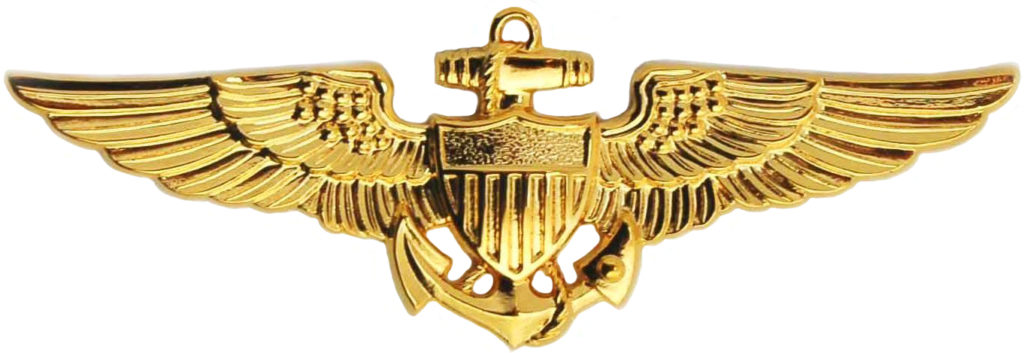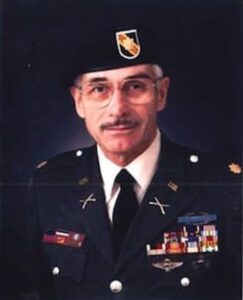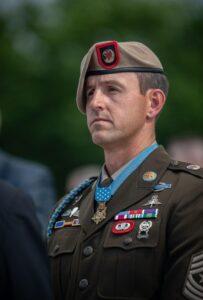- Date of Action: January 31, 1943
- Squadron: Marine Fighting Squadron 112 (VMF-112)
- Location: Near Kolombangara Island
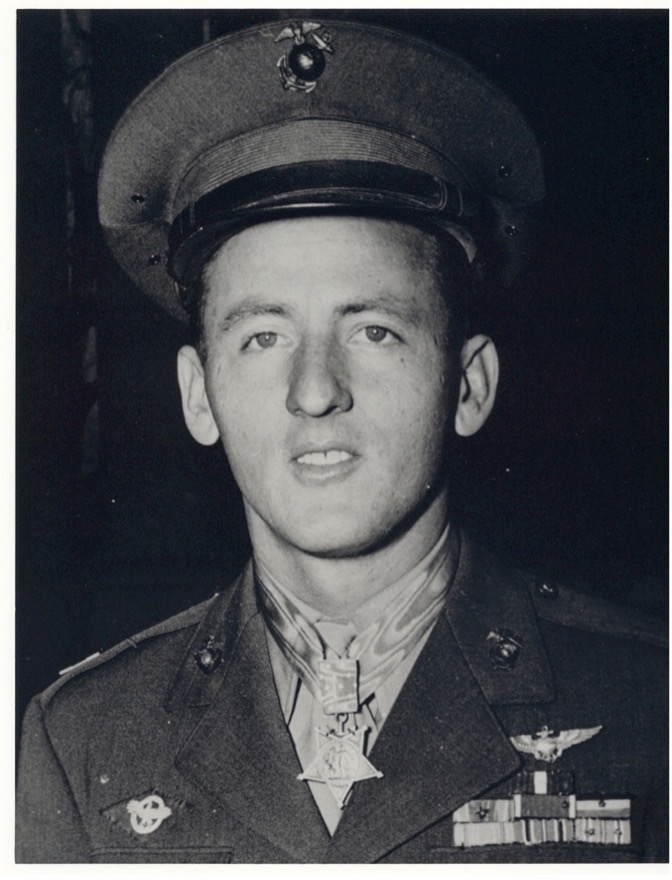
Commissioned in April of 1942, Jefferson De Blanc had only 290 hours of flying time to his credit before he was forced into combat in the skies around Guadalcanal Island. Despite his inexperience, De Blanc made an immediate impression, gaining two confirmed victories on his very first combat mission on November 12, 1942.
On January 31, 1943, De Blanc and seven other Marine Corps Wildcat pilots from Marine Fighting Squadron 112, were scrambled from Henderson Field to provide escort duties for twelve SBD-3 Dauntless dive bombers directed to attack a convoy of Japanese ships headed toward Guadalcanal Island. Carrying belly tanks to help improve their range, De Blanc noticed that the fuel gauge inside of his Wildcat, named “Impatient Virgin”, was indicating that his plane had a serious fuel transfer problem. Despite this looming fuel threat De Blanc continued on with the mission.
Near Kolombangara Island, De Blanc and the other American pilots reached the Japanese convoy almost 250 miles from Guadalcanal. As the Japanese ships began to fire their anti-aircraft guns, De Blanc noticed that a number of enemy float plane fighters had taken off and were headed toward the American dive bombers that had just finished their attack runs. While no match for a Wildcat fighter, the Mitsubishi F1M “Pete” biplane fighters were a threat to the slower Dauntless dive bombers. De Blanc and his wingman, Staff Sergeant Jim Feliton, dove down to attack two of the Petes now lining up behind one of the Dauntlesses. De Blanc guided his Wildcat in just behind the trail Pete. As the rear gunner on the Japanese biplane let loose with a machine gun, De Blanc ducked down below the tail and fired his .50 caliber machine guns. Flames poured from the stricken Mitsubishi, and it spiraled out of control. Moving quickly forward toward the lead Pete, De Blanc deftly maneuvered just below the field of fire of the rear gunner and attacked again. With the Japanese plane filling his gunsight, De Blanc destroyed his second float plane—as the bullets turned the Japanese plane into a fireball.
With the float plane threat now dealt with, De Blanc and Feliton sought to regain altitude. As they were climbing, the dreaded call of “Zeroes” filled the radio channel. Instead of the better-known Zeroes, it was ten Japanese Nakajima Ki-43 Hayabusa “Oscar” fighters that were above De Blanc. Fortunately, they had not seen De Blanc and his wingman climbing just below them. Picking out the lead Oscar, De Blanc maneuvered into position and fired into the fighter at close range. The Nakajima was hit and spiraled away—a victory that De Blanc later could not confirm. Continuing the fight, he turned his Wildcat toward the leader’s wingman and lined up his next target. Following the Oscar through a slow roll, De Blanc fired his .50 caliber machine guns. The bullets tore through the vulnerable Oscar and it shortly exploded in mid-air.
As the swirling dogfight continued, Sgt. Feliton’s Wildcat was hit by several rounds and was forced to depart. De Blanc also glanced at his fuel gauge and saw that his concerning fuel problem had only grown worse. Facing the real probability of having to ditch his plane at night in the contested waters below, De Blanc made the fateful decision to continue the fight against the remaining Oscars. He could only hope that his actions would help the Dauntless dive bombers to escape.
Two of the remaining Oscars located De Blanc’s Wildcat and engaged. While he was climbing to meet the Zeros, one of the enemy fighters lined up to attack him head-on. As the two planes raced toward one another, De Blanc let loose with his machine guns. As enemy bullets raced by his canopy, De Blanc’s rounds struck home. But now the risk of a head-on collision with the oncoming Oscar became frightfully real. Was the stricken Japanese fighter trying to collide with De Blanc? His rounds continued to shred the lightweight Nakajima and the Japanese fighter exploded in front of the Wildcat, showering the stout American fighter with debris as it passed through the fireball.
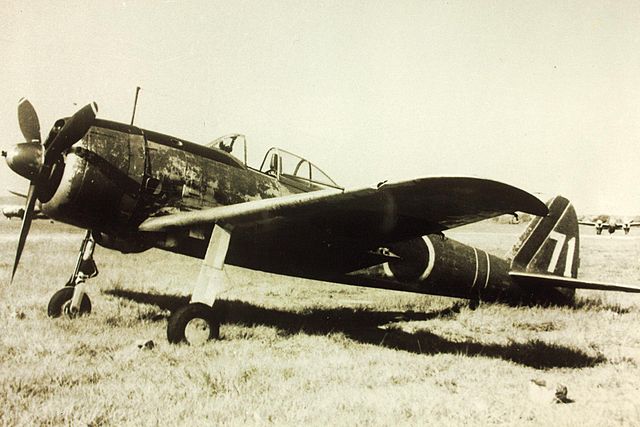
While De Blanc was dealing with the Oscar to his front other Japanese fighters had already lined up behind his Wildcat. With the sun beginning to set, De Blanc’s run of success was coming to a sudden halt. In an instant, “I felt the watch fly off my wrist and the instrument panel erupt in flames caused by a 20mm shell coming over my left shoulder.”* Other Japanese rounds struck his cowling and engine. De Blanc’s plane was as good as done and his mind quickly turned toward escaping the doomed aircraft. With the Wildcat falling apart, De Blanc worked loose the canopy, unbuckled his harness, and jumped out into the tropical air. Pulling his parachute cord, he pretended to be dead in his chute as he descended into the waters below. Once in the water, De Blanc realized that he had been wounded by shrapnel in his arm, leg, and left side. Making matters worse, his .45 caliber pistol and most of his other survival gear had been stripped from him during the descent.
De Blanc eventually swam toward the shore of Kolombangara Island, where he hid in the jungle and was returned to the Americans by friendly natives on the island in return for a bag of rice.
De Blanc’s wild combat of January 31, 1943, resulted in five confirmed victories, with additional probables—the first Marine Corps aviator to shoot down five enemy aircraft in one sortie. De Blanc was initially recommended for the Navy Cross, but this was later upgraded to the Medal of Honor, and the aviator received the nation’s highest military decoration from President Harry Truman in December 1946. A major factor playing into the decision to upgrade De Blanc’s decoration was his decision to risk his own survival so that he could protect the vulnerable dive bombers from the pursuing Japanese. De Blanc knew that keeping his gas-starved Wildcat in the fight would likely force him to ditch in the dark waters below. And yet, he made this selfless decision, which allowed the crews of the Dauntless dive bombers to safely return to their base. As he reflected on this choice, De Blanc would later state “[n]ow I’m not a brave man, but I have to live with myself.”
After the war, De Blanc went on to earn four different college degrees, including a doctorate in education. He taught mathematics and physics courses and also worked for South Central Bell telephone company.
* Likely a 7.7mm round since the Nakajima Ki-43 Hayabusa did not possess the 20mm cannons found on the Zero.
Medal of Honor Citation
For conspicuous gallantry and intrepidity at the risk of his life above and beyond the call of duty as leader of a section of six fighter planes in Marine Fighting Squadron 112, during aerial operations against enemy Japanese forces off Kolombangara Island in the Solomon group, 31 January 1943. Taking off with his section as escort for a strike force of dive bombers ordered to attack Japanese surface vessels, 1st Lt. DeBlanc led his flight directly to the target area where, at 14,000 feet, our strike force encountered a large number of Japanese Zeros protecting the enemy’s surface craft. In company with the other fighters, 1st Lt. DeBlanc instantly engaged the hostile planes and aggressively countered their repeated attempts to drive off our bombers, persevering in his efforts to protect the diving planes and waging fierce combat until, picking up a call for assistance from the dive bombers, under attack by enemy float planes at 1,000 feet, he broke off his engagement with the Zeros, plunged into the formation of float planes and disrupted the savage attack, enabling our dive bombers to complete their runs on the Japanese surface disposition and withdraw without further incident. Although his escort mission was fulfilled upon the safe retirement of the bombers, 1st Lt. DeBlanc courageously remained on the scene despite a rapidly diminishing fuel supply and, boldly challenging the enemy’s superior number of float planes, fought a valiant battle against terrific odds, seizing the tactical advantage and striking repeatedly to destroy three of the hostile aircraft (two float planes and one Zero) and to disperse the remainder. Prepared to maneuver his damaged plane back to base, he had climbed aloft and set his course when he discovered two Zeros closing in behind. Undaunted, he opened fire and blasted both Zeros from the sky in a short, bitterly fought action which resulted in such hopeless damage to his own plane that other Zeros entering the fight set his aircraft on fire forcing him to bail out over enemy waters between Vella Lavella and enemy-held Kolombangara. A gallant officer, a superb airman, and an indomitable fighter, 1st Lt. DeBlanc had rendered decisive assistance during a critical stage of operations, and his unwavering fortitude in the face of overwhelming opposition reflects the highest credit upon himself and adds new luster to the traditions of the U.S. Naval Service.
